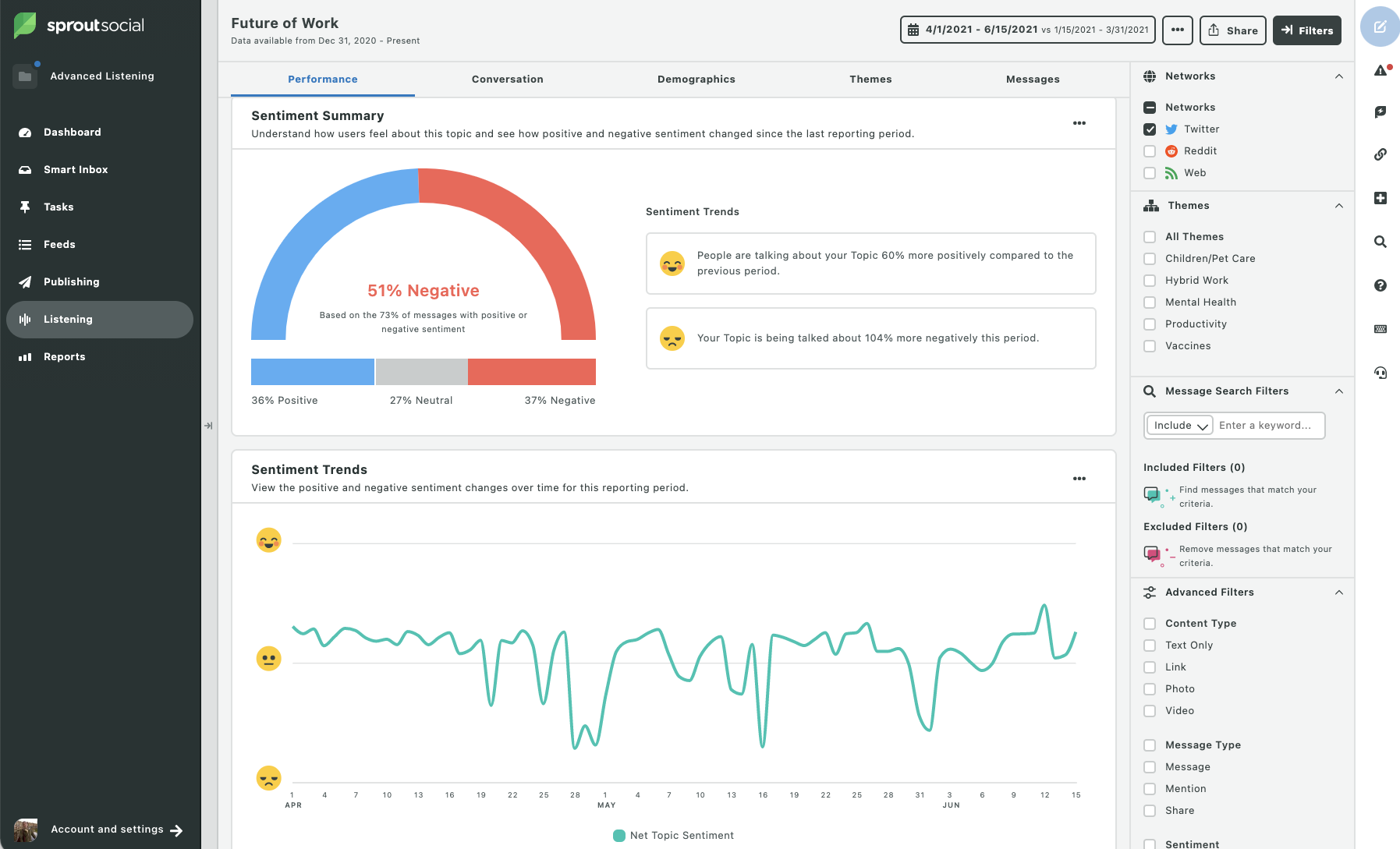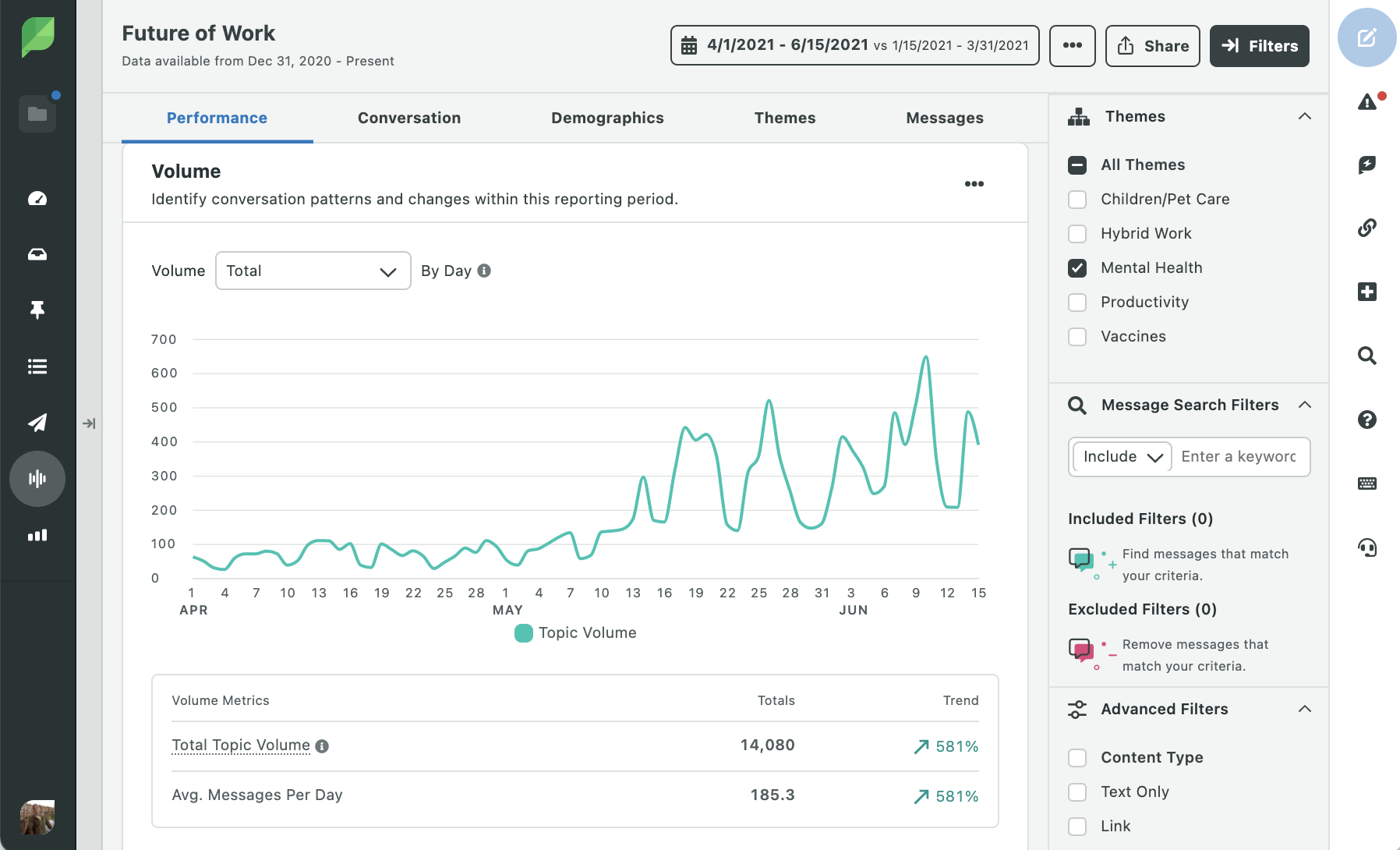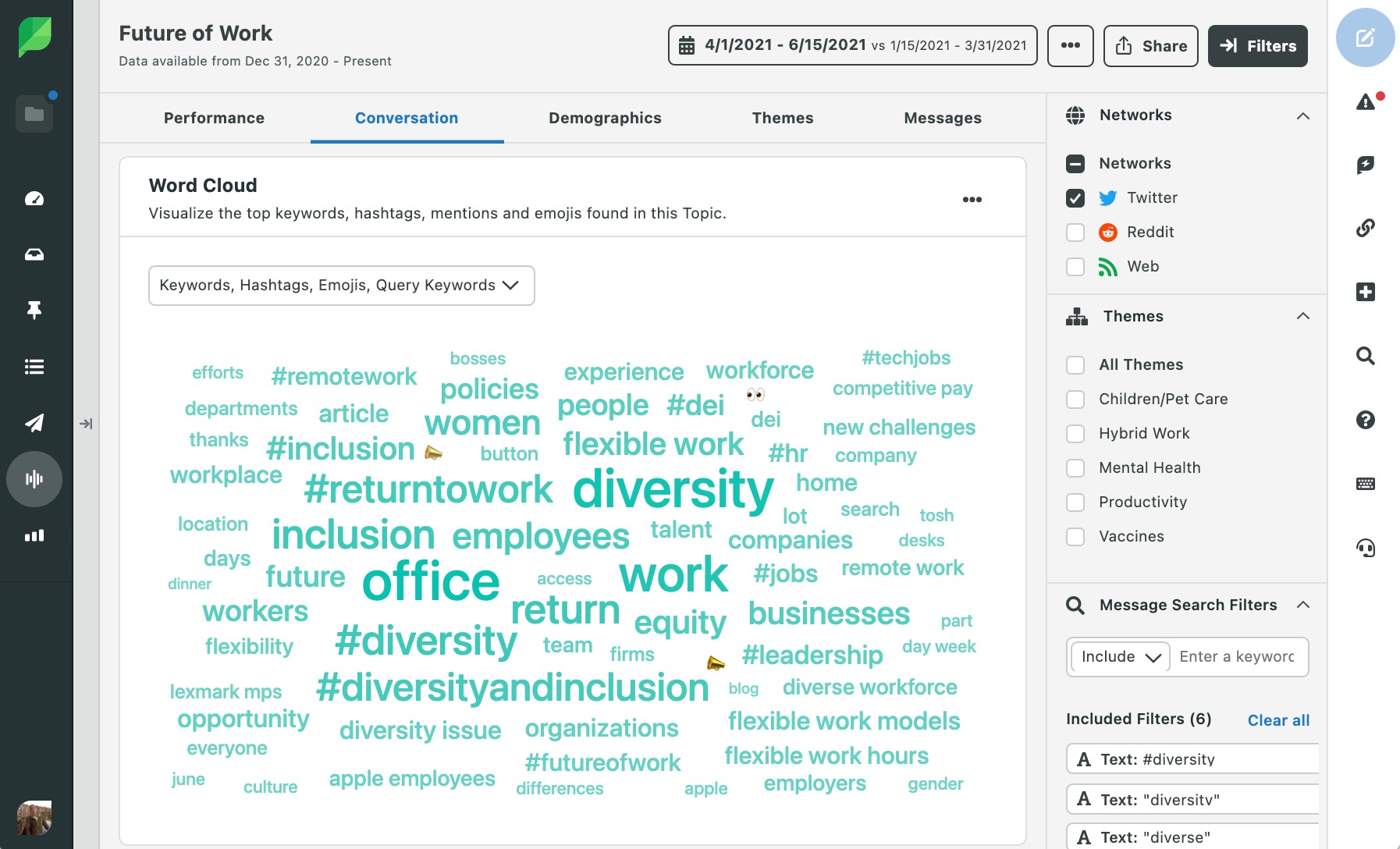It’s been over a year since the World Health Organization declared COVID-19 a pandemic and offices, stores and workplaces of all kinds shut down. What many of us thought would be a short stint of working from home quickly turned into our extended reality.
As COVID-19 cases dwindle, more people get vaccinated and mask mandates relax, employers worldwide are taking steps to define the future of work for their teams. For marketing leaders, this presents an opportunity to take stock of the expectations, operating procedures and rituals that should carry over post-pandemic—and those that should be left behind.
Using Sprout Social’s Advanced Listening, we analyzed over 149,000 messages across Twitter from April 1, 2021 to June 15, 2021, to learn more about how businesses are preparing for the future of work, how workers are reacting to it and how leaders can best support them no matter where they work.
People have mixed feelings about the future of work
As vaccination rates increase, conversations about reopening offices are simultaneously on the rise. What’s less consistent, however, is the way people feel about the future of work.
April 2020: working from home sucks
April 2021: if we have to go back to the office full-time I will quit— Sophie Vershbow (@svershbow) April 27, 2021
Of all the Tweets analyzed in our listening topic, 36% registered as positive, 27% as neutral and 37% as negative. By looking at the trend lines below, we can see how much sentiment changes on a daily basis.

For employers in the midst of office reopening plans, timing, transparency and communication are everything. Not everyone is ready to make the switch back to working in the office full-time, even if they are vaccinated, and respecting that could be a make-or-break for retaining talent.
All signs point to hybrid work models
A hybrid work model, where employees can split time between working in offices and remotely, is a popular compromise that businesses may embrace in lieu of returning to the office in full force.
Between April 1, 2021 and June 15, 2021, Tweets about hybrid work increased by over 240%. Unlike the future of work conversation at large, the 57% of these Tweets registered as positive, 26% neutral and only 17% negative.
The upward trend in conversations around hybrid work matches business trends. Even as some leaders remain reluctant about flexible work models, nine out of ten organizations worldwide plan to combine remote and on-site working.
Despite all the evidence that #WFH & hybrid #work schedules are a win-win, I expect some companies will inevitably bring people back to the office full-time.
Like a rubber band after being stretched out, it will return to it's original shape.
Some leaders just don't want change.— Mark C. Crowley (@MarkCCrowley) May 4, 2021
Embrace workers’ preferred working styles and environments
Harvard Business School Online recently commissioned a survey of professionals who worked remotely during the COVID-19 shutdown and found that working remotely didn’t hinder productivity, contrary to some executives’ opinions. In fact, it did quite the opposite.
One in three respondents felt they were more focused and that both their overall performance and quality of work improved while working at home.
While some roles are more naturally suited for an office environment, many marketers hold positions that can be done remotely, if that’s what they prefer. As businesses decide what working model is the best path forward, leaders should listen to their employees to gauge where and when they feel most productive.
In addition to capturing internal feedback through traditional employee surveys, businesses can use social listening to gain unfiltered views from the culture at large to influence their plans.
With vaccines widely available, companies are bringing employees back to the office. In March 2020, the idea of broadcasting from home was insane to me. Now, I think I do my best work here. I'm more productive. I work a lot longer, but overall, I'm MORE satisfied. Anyone else?
— Lyndsey Marie (@LyndseyOnAir) April 28, 2021
Take care of your social media team and their mental health
Social media managers in particular shouldered a lot of professional challenges in the last year. While some things slowed down during the events of 2020, data from the Harris Poll, on behalf of Sprout Social, revealed that social media use increased—and shows no signs of slowing down. Additionally, 90% of business executives reported that over the next three years, their company’s social media marketing budget will significantly increase.
The growing demands that come with a social role, coupled with the “always on” nature of social, make burnout a very real challenge that employers need to keep an eye on.
Within our listening topic, we found that message volume around mental health and burnout has started ballooning as more workplaces open back up.

For some, the flexibility and autonomy of remote work may help minimize burnout. For others, the structure and communal nature of an office are beneficial for mental health. Rather than make the decision for employees, business leaders should ideally hear them out about what they feel is best for their long-term wellbeing.
Remote work is a disability concern. It’s a women’s concern. It’s a people-who-want-better-mental-health concern. If you want to go back to the office, nobody is stopping you. But you should not step on the rest of us.
— Shantini (@shanti209) June 5, 2021
For the extroverts who love being around people:
It's great that you are excited about going back to the office and being around your peers again, but please remember there are A LOT of people who are less productive, anxious, easily distracted, etc, in office environments. 1/3— elhector (@elhector) May 27, 2021
Distributed teams can open doors for more diverse talent
There are numerous long-term benefits companies can reap from adopting these working models. One, in particular, stands out: inclusive hiring opportunities.

Distributed, remote teams mean that location no longer dictates a job seeker’s role or worth from a salary perspective. Eliminating location bias from the equation opens the door for more diverse talent, which is good news for marketers.
Marketing teams that include diversity of thought, experience, cultures and background have a better chance of connecting with diverse audiences, which should always be a goal.
“As we look to the post-pandemic workplace, leaders have an opportunity to redesign their processes, policies and norms with the central principles of diversity, equity and inclusion, including making flexible work core to your working model.” https://t.co/RB0dci8qmI
— Jenni Field (@mrsjennifield) April 17, 2021
The future of work is now
The great work from home experiment has yet to reach its conclusion, but results have shown that remote or hybrid models are here to stay long-term. No matter which path a business takes going forward, employers should keep listening to their people throughout all phases of reopening or rethinking how their teams work. With their guidance and feedback, businesses can continue evolving their work policies.
Social listening gave us insights into what the future of work looks like. It’s also helped Sprout customers and employees answer questions like “What day is leg day?” Read more to get the answer to that and eight other questions.
The post Office reopening? How to help your marketing team navigate the future of work appeared first on Sprout Social.
